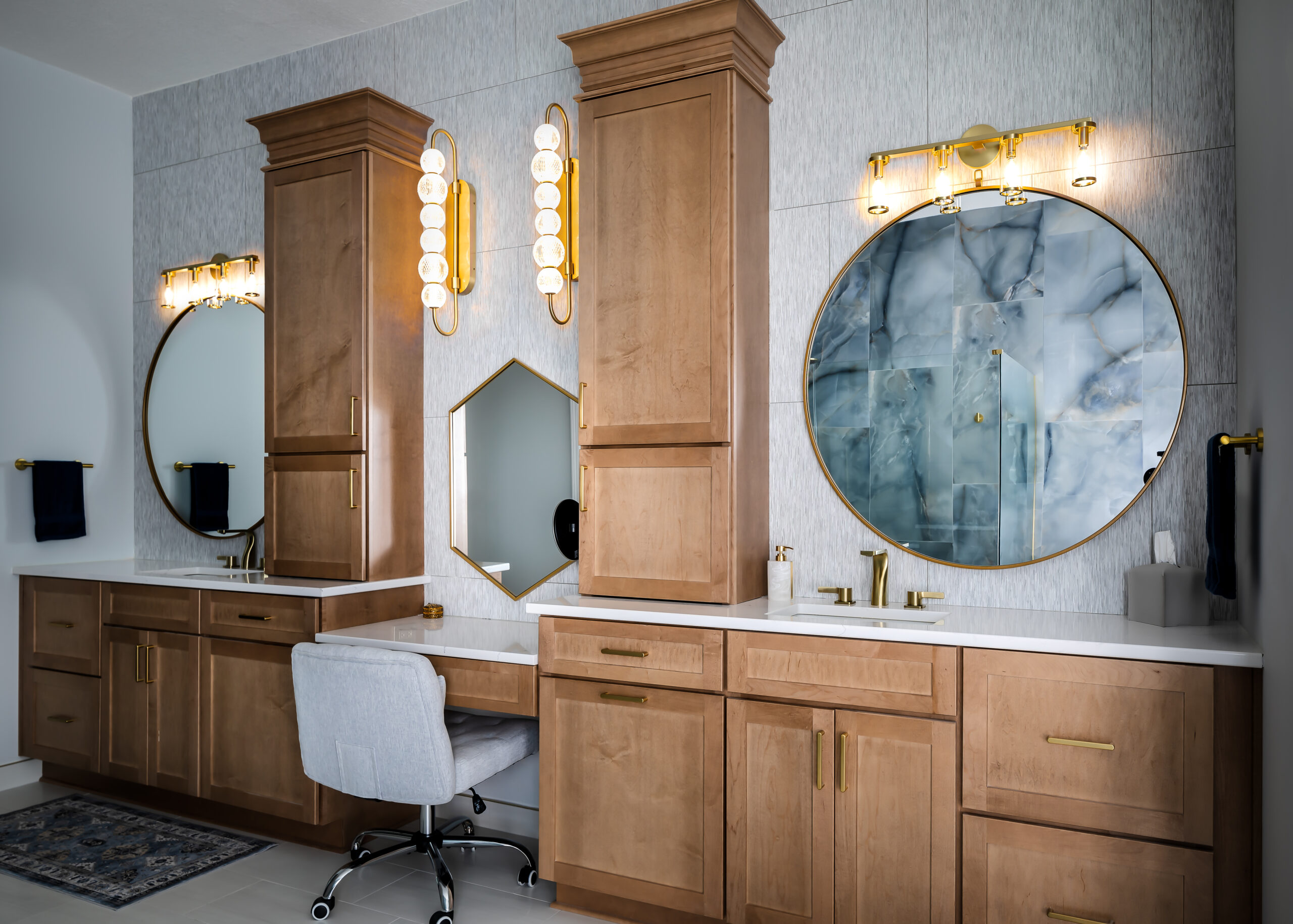If you’re looking to elevate your bathroom’s design, you can do it literally. It might be time to consider a floating vanity. These stylish, space-saving solutions are making waves in modern interiors, offering both function and flair. Plus, let’s be honest. Who doesn’t love a little magic trick in their home? What do you think of a vanity that appears to hover off the ground? It’s like your bathroom finally learned the art of levitation. Keep reading below for more insights from the experts at Karin Ross Designs.
What Is a Floating Vanity?
A floating vanity is a bathroom vanity mounted directly to the wall, leaving open space between the bottom of the vanity and the floor. Unlike traditional vanities that sit flush with the ground, floating bathroom vanities create an airy, contemporary look while making cleaning a breeze. They come in various styles, from sleek modern floating vanities with seamless lines to more detailed, rustic designs with open shelving.
Beyond aesthetics, these vanities also provide practical benefits. They can make small bathrooms feel larger by opening up the visual space, and they offer customizable height options to suit your needs better. Whether you’re going for minimalism or a luxury spa feel, a floating vanity can be the perfect addition to your bathroom remodel.
Are Floating Vanities Hard to Install?
The installation process can be more complex than traditional vanities, but it’s definitely doable with the right approach. Because legs or a base don’t support a floating bathroom vanity cabinet, it needs to be securely mounted to wall studs for safety and durability. If you’re handy with tools, you can take this on as a DIY project. However, if words like “stud finder” and “toggle bolts” make your head spin, hiring a professional might be the best route.
How to Install a Floating Vanity
- Locate the Wall Studs – Use a stud finder to ensure you’re securing the vanity to solid wood, not just drywall. Securing the vanity to solid wood is crucial for stability.
- Mark Your Measurements – Determine the ideal height for your vanity (more on that below) and mark the spots where it will be mounted.
- Secure the Vanity Bracket – Many floating vanities come with a mounting bracket that needs to be drilled into the studs before attaching the vanity itself.
- Mount the Vanity – Once the bracket is in place, attach the vanity and double-check for levelness.
- Connect Plumbing – If you’re installing a sink, reconnect the plumbing, ensuring there are no leaks.
If you’re not confident in your skills, a bathroom remodeling company in Kansas City can handle this for you, ensuring that your floating vanity is secure and functional.
How High Should a Floating Vanity Be?
The standard height for a floating vanity is typically between 32 and 36 inches from the floor to the countertop. However, since floating vanities aren’t bound to floor-based measurements, you have more flexibility to customize the height based on your needs.
For shared or family bathrooms, a height of around 34 to 36 inches is ideal, while in powder rooms or children’s bathrooms, lowering it to 30 to 32 inches might be more comfortable. The key is balancing comfort, functionality, and style.
Are Floating Vanities Sturdy?
One of the biggest concerns homeowners have about floating vanities is whether they’re sturdy enough for daily use. The answer? Absolutely, but only if they’re installed correctly. When properly mounted to wall studs, floating vanities can support significant weight, including countertops made of quartz, marble, or other heavy materials.
However, if the installation is rushed or done without proper reinforcement, you could end up with a vanity that feels wobbly or, in the worst case, pulls away from the wall over time. That’s why it’s essential to follow best practices or hire professionals for installation. A well-installed floating vanity can last for years without any issues.
Floating Makeup Vanity
Floating vanities aren’t just for sinks. They can also be used as sleek makeup stations. A floating makeup vanity provides a stylish and functional spot for your daily beauty routine, keeping all your essentials within reach while maintaining a modern aesthetic.
Adding built-in lighting or a backlit mirror can elevate the look even further. Some homeowners also opt for additional floating storage beneath the vanity to keep makeup and skincare products organized without cluttering the countertop. Whether incorporated into a master bathroom or a separate dressing area, a floating makeup vanity can enhance both convenience and style.
The Final Touch in Modern Bathroom Design
Floating vanities are more than just a passing trend. They’re a functional, stylish solution for contemporary bathrooms. They open up space, make cleaning easier, and allow for a customized height that suits your needs. Whether you’re drawn to the sleek lines of a modern floating vanity or need the practicality of a floating bathroom vanity cabinet, there’s a design out there for every style.
If you’re considering a bathroom remodel, why not literally take your space to new heights? View our bathroom remodels to see how a floating vanity could transform your space. Ready to get started? Schedule a remodeling consultation today to bring your vision to life.










